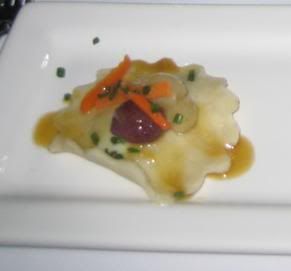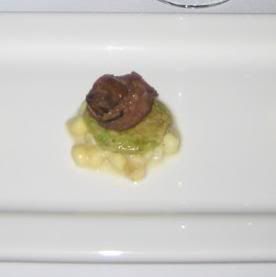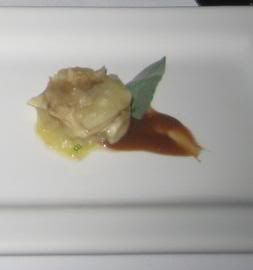 We conclude our three-blog review of recently commissioned and completed celebratory desserts with another cheesecake. Our clients seem to really enjoy our cheesecakes, especially to celebrate birthdays!
We conclude our three-blog review of recently commissioned and completed celebratory desserts with another cheesecake. Our clients seem to really enjoy our cheesecakes, especially to celebrate birthdays!Saturday, July 28, 2007
a trio of celebratory desserts: conclusion
 We conclude our three-blog review of recently commissioned and completed celebratory desserts with another cheesecake. Our clients seem to really enjoy our cheesecakes, especially to celebrate birthdays!
We conclude our three-blog review of recently commissioned and completed celebratory desserts with another cheesecake. Our clients seem to really enjoy our cheesecakes, especially to celebrate birthdays!Thursday, July 26, 2007
a trio of celebratory desserts... part 2
 Our second dessert featured in the "trio of celebratory desserts" was created for a discerning client's birthday. We wanted to create something classic, with a fresh and modern twist... an 'orenji twist,' if you will!
Our second dessert featured in the "trio of celebratory desserts" was created for a discerning client's birthday. We wanted to create something classic, with a fresh and modern twist... an 'orenji twist,' if you will!Wednesday, July 25, 2007
a trio of celebratory desserts...
 We have had a run of orders for celebratory desserts lately, here at orenji catering. Mainly, these desserts have been commissioned by our clients in celebration of friends' or coworkers' birthdays. We are always flattered and excited to be a part of a special celebration... and especially enjoy the challenge of creating a "new" dessert for the occasion. Our next three posts will highlight three such recent creations...
We have had a run of orders for celebratory desserts lately, here at orenji catering. Mainly, these desserts have been commissioned by our clients in celebration of friends' or coworkers' birthdays. We are always flattered and excited to be a part of a special celebration... and especially enjoy the challenge of creating a "new" dessert for the occasion. Our next three posts will highlight three such recent creations...
The first of our "trio of celebratory desserts" was a small cheesecake that we created for an intimate birthday gathering. Our client indicated that the birthday girl enjoyed "fruit and chocolate," and let the rest up to us. So, naturally, we ran to the orenji catering test kitchens and set to work. In the end, our pastry chef created what he calls a "Re-invented Black Forest Cheesecake."
Traditionally, a Black Forest Gateau (or cake) is comprised of layers of chocolate cake, alternating with whipped cream and cherries. Common in Southern Germany, the cake layers are generally soaked with Kirschwasser-- a clear cherry brandy.
In re-inventing the dessert, we hoped to capture the original elements of a traditional Black Forest Gateau (chocolate, cherries, cream, brandy), while translating them to a cheesecake.
The cheesecake was stacked two layers high-- the bottom layer flavored with Belgian milk chocolate, and the top layer with white chocolate. A dark, crunchy chocolate cookie crust provided a much needed textural contrast and sweet foil for the mildly-sweetened cheesecake layers. Here at orenji catering we believe that the best cheesecakes are those that aren't so sweet as to be cloying, but rather, are just sweet enough to tickle the palate.
We then created a vanilla-infused compote of fresh locally produced cherries, which we added a splash of brandy too. Once chilled and thickened, we topped our two-layer cheesecake (representing the chocolate cake and whipped cream layers of the traditional dessert), with the compote. Belgian bittersweet chocolate lattice and decoration, as well as white chocolate curls completed this festive dessert.
We were pleased with our re-invented Black Forest Cheesecake, and hope it made our clients' friend's birthday gathering a smashing success. We look forward to creating a delicious dessert for your next event!
Sunday, July 22, 2007
a birthday degustation: the menu
 Some of our readers have asked us to post a "clean" copy of the menu for our recently described chef's degustation and wine tasting event. We are happy to do so. To access a copy of the menu, please visit the link below. As always, thank you for your continued support of orenji catering.
Some of our readers have asked us to post a "clean" copy of the menu for our recently described chef's degustation and wine tasting event. We are happy to do so. To access a copy of the menu, please visit the link below. As always, thank you for your continued support of orenji catering.
We look forward to creating a spectular event for you!
To view the chef's degustation and wine tasting menu, please visit:
http://www.box.net/shared/mkdeo20j0l
Saturday, July 21, 2007
a birthday degustation: mignardises
 The coverage of our chef's degustation menu and wine tasting menu draws to a close with our final offering created for our happy and satisfied guests-- mignardises.
The coverage of our chef's degustation menu and wine tasting menu draws to a close with our final offering created for our happy and satisfied guests-- mignardises.
Mignardises are small, sweet bites served at the conclusion of a meal, following dessert. These provide smooth tastes with which to comfort the palate. Oftentimes, mignardises mix sweet and savory flavors, acid or tart flavors, or even unexpected spices or herbs. The mignardises prepared by our chef were no exception. We paired our "final bites" with a natural chocolate infused Port wine (Deco, Sonoma Valley Port Works) as well as our favorite blend of coffee--dark roast French Press "Over the Rhine" blend coffee (see Over the Rhine link at the left for ordering information). Both the sweetness of the Port, and the smooth, deep (yet mellow) flavors of the organic (free trade) dark roast coffee were perfect endings to a wonderful evening.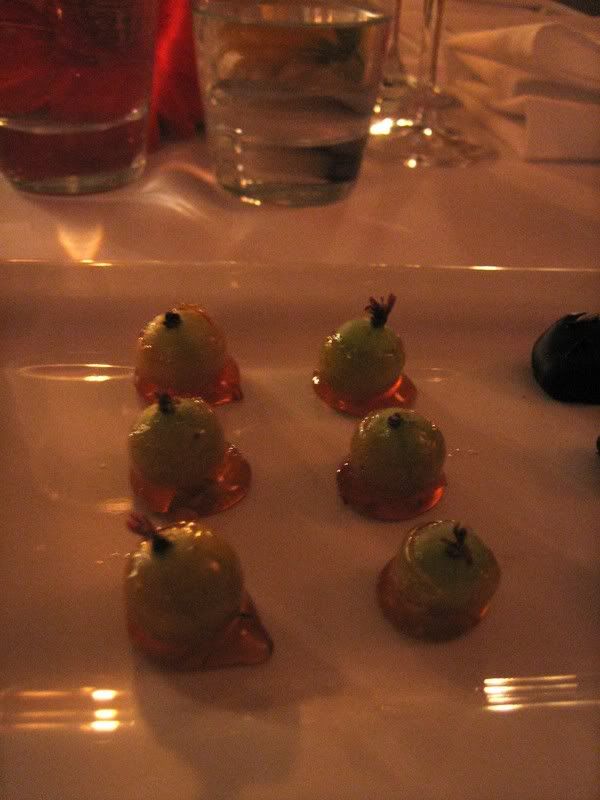
The first of our mignardises was inspired by our recent culinary adventures in Peru. As you may recall from previous blogs, we posted about our incredible meal at Astrid y Gaston-- Lima's premiere culinary destination. There, we experienced caramelized cape gooseberries (known as maracuya)-- an Amazon basin berry with a sour and tart green flesh. As cape gooseberries are not available in US markets, we opted for the smaller (and slightly sweeter) domestic gooseberry... which we bathed in several coatings of hand caramelized sugar until the fruit glowed amber in the light of the candles. The sweet of the sugar and the sour of the fruit worked hand in hand to create a complimentary-- yet oppositional-- blend of flavors.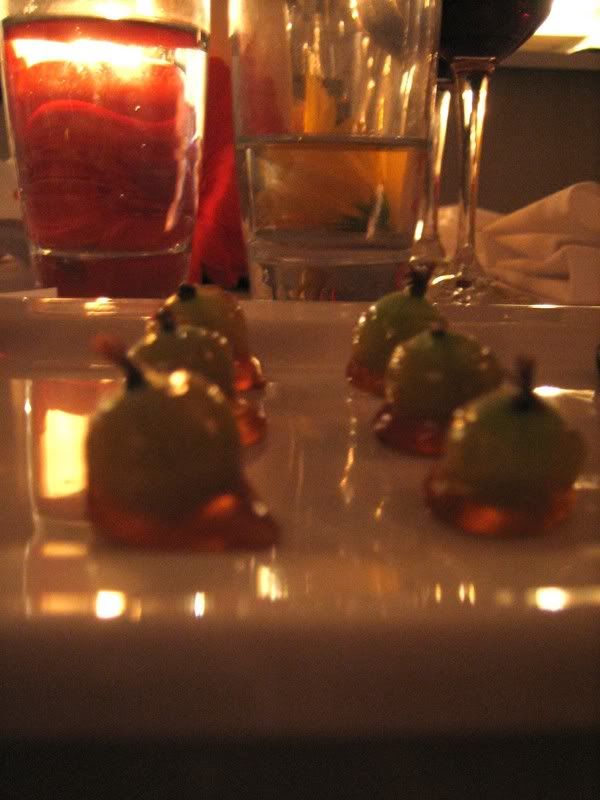
The second (of four) mignardises we served began with fennel root, which we slow braised and subsequently candied into a smooth, sweet fennel paste. After shaping the paste, we enrobed it in deep, rich Belgian bittersweet chocolate, and topped it with a toasted fennel seed. The sharpness of the fennel, and the bitterness of the chocolate worked together to balance the sweetness of the candying syrup and the toasted crunch of the fennel seed.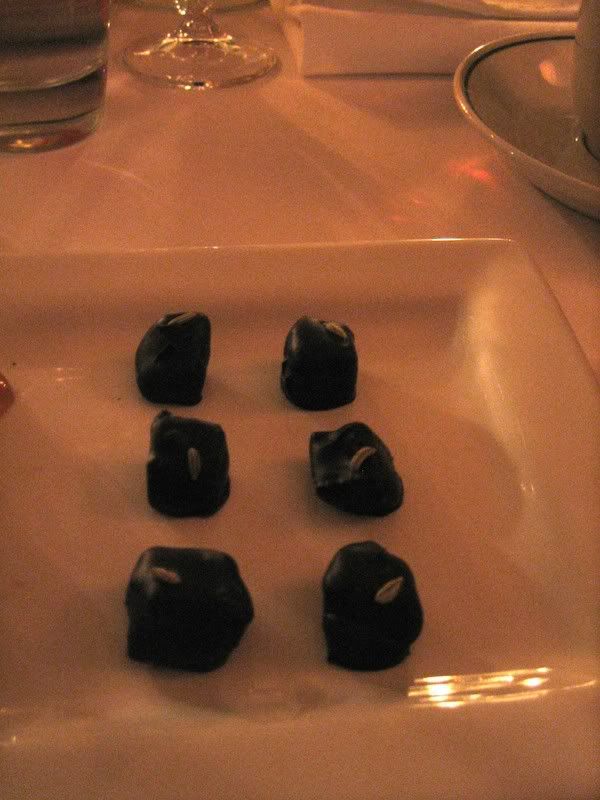
Our third offering was a classic truffle with an orenji twist. We began with a milk chocolate truffle base, which we infused with garam masala-- a sweet-spicy blend of Indian spices. The sweetness of the milk chocolate, coupled with the spicy and deep undertones of cinnamon and cardamom make this one of our favorite flavor combinations. The truffles melted in the mouth, leaving a slight heat from the spice on the tongue.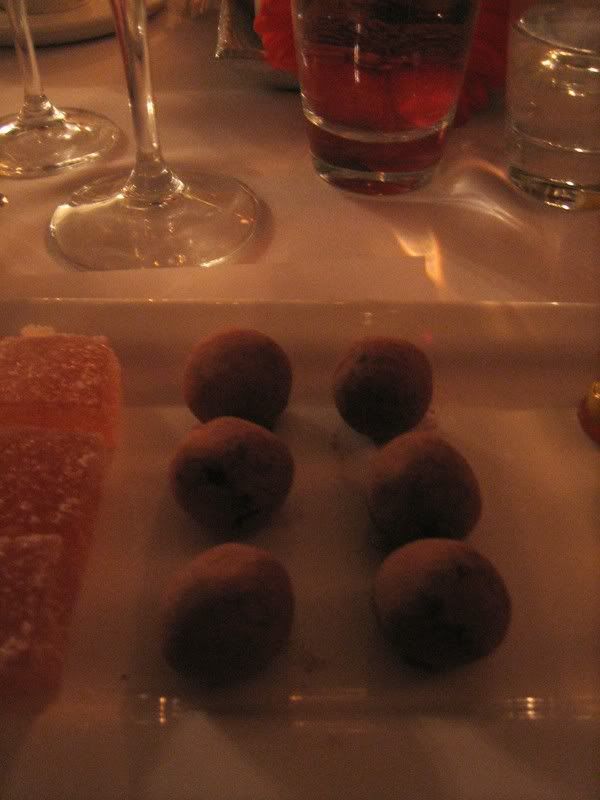

Our last taste offering were hand cut "jellies" made from the juice of the yuzu. Yuzu is a small Japanese citrus fruit, similar in color to the lemon, but with a more sour juice. The yuzu juice was cooked down with pectin until it thickened, chilled, cut into squares, and rolled in vanilla-scented granulated sugar. The overall result was surprising and different from the remainder of the mignardises-- in both flavor and texture. We would eat these as a healthy natural snack any day of the week!
The four mignardises brought our chef's degustation and wine taste to a close. We feel like it was the perfect birthday event for our friend and client-- an opportunity to experience may different types of food, expanding the palate in the process. We look forward to being called upon in the future to create another such event, as the culinary possibilities are endless!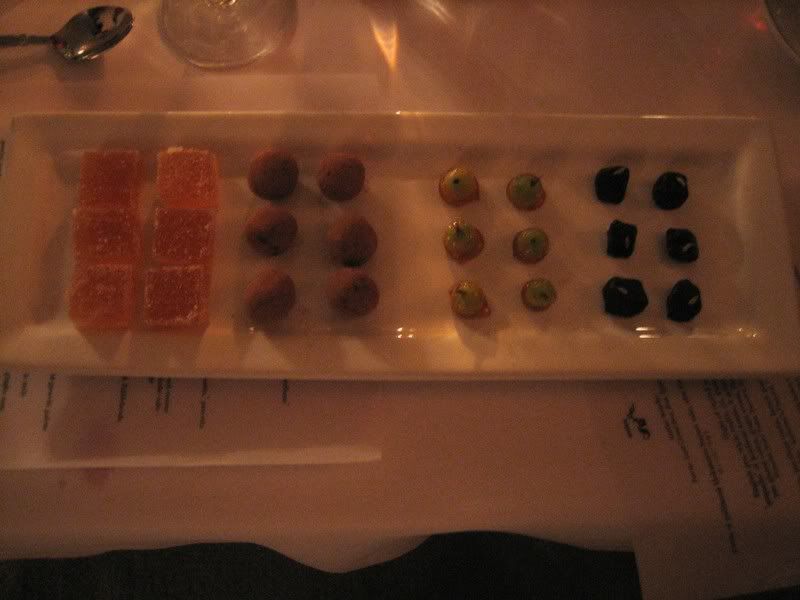
Thursday, July 19, 2007
a birthday degustation: course eleven (dessert!)
 We near the conclusion of our coverage of the recently prepared birthday degustation with our arrival at the dessert course. Our chef got his start in pastry, so dessert remains near and dear to his heart. We think he pulled out all the stops with this delicious chocolaty confection. Paired with a 10 year old tawny Port by Taylor Fladgate, this dessert was a natural conclusion to the eleven plated courses of the degustation.
We near the conclusion of our coverage of the recently prepared birthday degustation with our arrival at the dessert course. Our chef got his start in pastry, so dessert remains near and dear to his heart. We think he pulled out all the stops with this delicious chocolaty confection. Paired with a 10 year old tawny Port by Taylor Fladgate, this dessert was a natural conclusion to the eleven plated courses of the degustation.
The dessert started with a deliciously molten chocolate and banana bread pudding. The base of the bread pudding was a homemade banana bread, which was soaked in a bittersweet chocolate custard (made with Belgian bittersweet chocolate). A ball of bittersweet ganache was placed in the middle of the individual bread pudding molds, which when cooked, melted into a molten core.
Atop the bread pudding was placed a layer of caramelized bananas, and atop that was placed a macadamia nut-caramel crispy tuile. The tuile added a delightfully crisp contrast to the molten pudding and the creamy bananas. A scoop of homemade malt ice cream sat atop the crisp, the warmth of the warm bread pudding softening-- and then melting-- the ice cream into a smooth and creamy malt-infused sauce. Some Belgian bittersweet chocolate lattice completed the "tower" of dessert components.
The warm molten chocolate and banana bread pudding was garnished with a bittersweet chocolate ganache infused with banana rum, and a sea salt caramel sauce. All in all, it was a sweet ending to the plated meal... and coupled with the deliciously deep flavors of the Port, we couldn't have asked for a richer and smoother conclusion to our degustation.
Of course, the meal wasn't necessarily over! Up next, our chef tickles our guests' taste buds one last time with a selection of mignardises, infused Port, and dark roast coffee. Check back. You don't want to miss this!
Wednesday, July 18, 2007
a birthday degustation: course ten
 The second of our plated cheese courses prepared recently at our chef's degustation and wine tasting menu (in honor of our friend and client's birthday), was much deeper in flavor and denser in texture than the previous. Coupled with a ripe, fruity Bordeaux (Chateau Ballan-Larquette, Bordeaux, France, 2005), the flavors of this course needed to stand up to the bold wine it was served with. Again, our choice of plateware reflected the French techniques of the origins and ingredients used in the preparation of this dish.
The second of our plated cheese courses prepared recently at our chef's degustation and wine tasting menu (in honor of our friend and client's birthday), was much deeper in flavor and denser in texture than the previous. Coupled with a ripe, fruity Bordeaux (Chateau Ballan-Larquette, Bordeaux, France, 2005), the flavors of this course needed to stand up to the bold wine it was served with. Again, our choice of plateware reflected the French techniques of the origins and ingredients used in the preparation of this dish.
Our chdese course was inspired by another great American chef-- Charlie Trotter. When we dined at Chef Trotter's flagship restaurant in Chicago some years back, we were served a creation reminiscent of this cheese course. We have been looking for a reason ever since to re-create this delicacy, with our own orenji twist!
The base of this cheese course is Explorateur cheese-- a soft and creamy mold-ripened triple-cream French cheese. The amount of cream and fat in the cheese results in a smooth and creamy texture, despite the aging process. For our course, we wrapped the cold cheese in some hand made porcini mushroom crepes, and heated them gently until the cheese melted. Served with the crepes was a thick, warm, coulis of port-wine stewed Medjool dates. The dates were slow cooked with natural sweeteners and spices, breaking down their tough texture, and infusing them with the concentrated sweetness of the port wine.
The dish was finished with a fresh black trumpet chantarelle mushroom, caramelized with Chinese five-spice powder. Together, the smooth (yet acidic and somewhat "barnyardy") cheese, with the deep umami flavor of the mushrooms, and the sweet fruity dates came together to create a seamless blend of complementary flavors. We would make this cheese course again and again... and we probably will!
This nearly brings us to the end of our degustation menu trip down memory lane. Up next, the final course: dessert. Be sure to check back and see what our chef whipped up in the pastry kitchen!
Tuesday, July 17, 2007
a birthday degustation: course nine
 Course nine of our chef's degustation and wine taste was the first of two plated cheese courses. The course focused on the interplay between sweet and salty. The centerpiece of the cheese course was a small wedge of sweet and savory cheesecake-- made with white Stilton cheese (an English mold injected "bleu" cheese) and dried apricots. The cheesecake sat upon a crust of Japanese sesame crackers and nori (dried seaweed), which added a salty undertone to the sweet cheesecake. Served with the "confection" were some baby field greens in a light sesame vinaigrette topped with caramelized spicy ginkgo nuts.
Course nine of our chef's degustation and wine taste was the first of two plated cheese courses. The course focused on the interplay between sweet and salty. The centerpiece of the cheese course was a small wedge of sweet and savory cheesecake-- made with white Stilton cheese (an English mold injected "bleu" cheese) and dried apricots. The cheesecake sat upon a crust of Japanese sesame crackers and nori (dried seaweed), which added a salty undertone to the sweet cheesecake. Served with the "confection" were some baby field greens in a light sesame vinaigrette topped with caramelized spicy ginkgo nuts.Monday, July 16, 2007
a birthday degustation: course eight
 The eighth course of our recently prepared chef's degustation and wine tasting was the "salad course." Given the length of the meal, our chef wanted to serve a light and refreshing salad-- something non-traditional to re-awaken the palate and prepare our guests for cheese and dessert courses. Staying true to our culinary aesthetic and vision for this degustation, we selected local heirloom tomatoes as the focal point for this delicious and beautiful plate.
The eighth course of our recently prepared chef's degustation and wine tasting was the "salad course." Given the length of the meal, our chef wanted to serve a light and refreshing salad-- something non-traditional to re-awaken the palate and prepare our guests for cheese and dessert courses. Staying true to our culinary aesthetic and vision for this degustation, we selected local heirloom tomatoes as the focal point for this delicious and beautiful plate.
Heirloom tomatoes are tomato plants that have traditionally not been cross-bred or made into hybrids. While there is debate on the definition, general agreement suggests that the seeds of a tomato need be at least 50 years old (with some experts suggesting a more restrictive 100 years) to be considered a true heirloom. These tomatoes come in a variety of shapes, sizes, and colors-- most with very interesting and "non-commercial" appearances compared to the glossy red and round tomatoes found in most supermarkets. They generally have tastes ranging from smooth and sweet to hard and sour.
Beginning at the base, we plated a coulis of fresh local plum tomato "tartare," surrounded by freshly infused basil oil. In the center of the "tartare," we placed a crisp brioche crouton, which was topped with peeled and chilled petite gold, red, and green summer tomatoes tossed in olive oil, sea salt, and black pepper. Dividing the layers of tomatoes was a Parmesan and garlic tuile, adding a deep flavor and crisp texture.
Sitting gloriously atop the tomato "salad" was the crowing achievement of this particular course-- an heirloom tomato sorbet. The sorbet was created from a blend of four types of local heirloom tomatoes-- the Big Rainbow (yellow fleshed), the Brandywine (pink-red fleshed), the Green Zebra (green fleshed) and the Jubilee (golden fleshed). Together, they created a delightful orange-coloured sorbet, sweetened naturally by the sugar in the tomatoes, and infused with basil and thyme. As the sorbet melted, it created a deliciously cool and sweet "dressing" for the salad, enjoyed by all.
Finally, sitting on top of the sorbet was a piece of "tomato paper"-- another foray into the world of molecular gastronomy. In this case, peeled, seeded, and chopped tomato flesh is slowly dehydrated until is creates a thin and flexible tomato-scented "paper." It was the perfect topper for our heirloom tomato showpiece!
Having completed the savory portions of our meal, we next turn our attention to plated cheese courses, desserts, and mignardises. You don't want to miss the sweet endings to our chef's degustation and wine taste!
Thursday, July 12, 2007
a birthday degustation: course seven
 We turn our attention to the seventh course of our recently prepared birthday degustation menu and wine tasting. Course seven (not including our sorbet and amuses bouche, of course), was the "meat course," and as such, was designed with the richest, boldest flavors in mind-- as compared to the remainder of the courses served. It was also one of the most attractive plates served during the course of the evening, followed closely (in our humble opinion) by the salad course (to be described in a later post).
We turn our attention to the seventh course of our recently prepared birthday degustation menu and wine tasting. Course seven (not including our sorbet and amuses bouche, of course), was the "meat course," and as such, was designed with the richest, boldest flavors in mind-- as compared to the remainder of the courses served. It was also one of the most attractive plates served during the course of the evening, followed closely (in our humble opinion) by the salad course (to be described in a later post).
The meat course began with a breast of free-range veal, which was oven-braised overnight in a stock infused with red wine, roasted shallots, juniper berries, fresh herbs, and root vegetables. The breast was deboned, cooled, weighted, and cut into medallions. The medallions were later coated with mustard and panko (Japanese bread crumbs) and pan-seared prior to serving.
Accompanying the veal medallion was a galette (a French descriptor for a "round and crusty type of cake") made from freshly rolled gnocchi, fresh herbs, and semolina flour, which was pan-fried to a golden crispy brown prior to serving.
To serve, the pan-seared veal was placed atop the pan-fried gnocchi galette. The meat was then topped with a warm salad of root vegetables (yellow and ruby beets, parsnips, turnips, carrots), fresh thyme, and sweet garlic. The garlic was steeped in boiling milk repeatedly to remove the bitterness, and then quickly sauteed with some sugar and beurre monte to aid in caramelization.
The entire "stack" of components was topped with a reduction of the poaching liquid that had been infused with the earthy tang of juniper berries. Lastly, the plate was dotted with juniper berry-infused oil to tie the flavors together. Overall, the crispness of the galette perfectly complimented the tender braised veal, with the fresh crunch of the root vegetables and sweet garlic rounding out the preparation both in texture and in taste.
The meat course was paired with a California Cabernet Sauvignon, 337, from Lodi (2005). The wine was bold and smooth, and perfectly complimented the cuisine. In this case, we couldn't have asked for a better pairing! Check back soon to see what all the buzz is about the plated salad course. You don't want to miss it!
Wednesday, July 11, 2007
a birthday degustation: trio of sorbets
 After experiencing the various flavors of several courses on our chef's degustation menu (including the amuses bouche, flight of chilled soups, pan roasted black cod, artichokes prepared three ways, and earl grey tea infused duck breast-- all reviewed in previous blog entries), it was time to freshen our guests' palates and prepare them for the remainder of of the journey. To do so, we offered guests a trio of sorbets, each with complimentary flavors to stimulate different portions of the taste buds.
After experiencing the various flavors of several courses on our chef's degustation menu (including the amuses bouche, flight of chilled soups, pan roasted black cod, artichokes prepared three ways, and earl grey tea infused duck breast-- all reviewed in previous blog entries), it was time to freshen our guests' palates and prepare them for the remainder of of the journey. To do so, we offered guests a trio of sorbets, each with complimentary flavors to stimulate different portions of the taste buds.Tuesday, July 10, 2007
a birthday degustation: course six
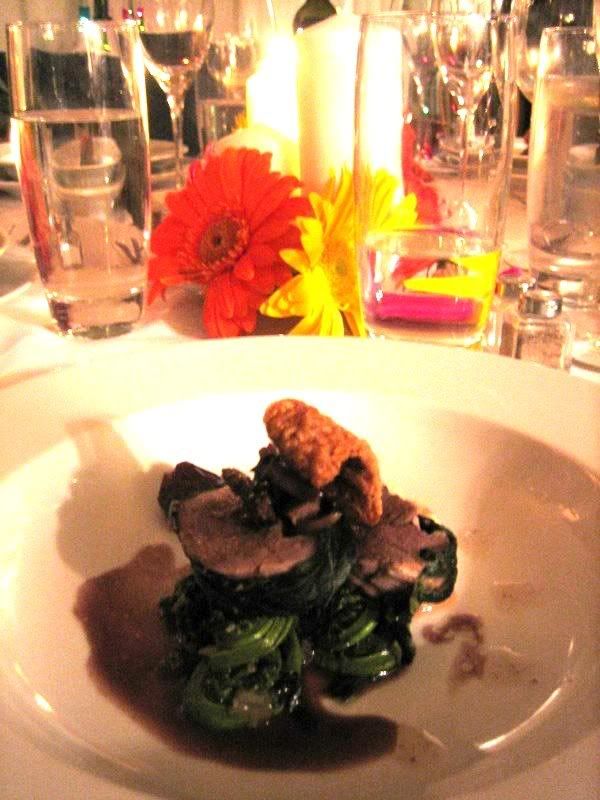 We continue our review of our recently prepared chef's degustation menu with a discussion of the poultry course that followed our presentation of a trio of artichokes. As you may recall, degustation menus present many small bites of various types of food and flavors, served in succession. Each course builds upon the last, and this duck preparation was no exception. Strong in flavor, the duck was a perfect course to precede a palate-cleansing intermezzo, and the "entree" of the degustation, oven braised veal breast... but more on those menu items in later posts!
We continue our review of our recently prepared chef's degustation menu with a discussion of the poultry course that followed our presentation of a trio of artichokes. As you may recall, degustation menus present many small bites of various types of food and flavors, served in succession. Each course builds upon the last, and this duck preparation was no exception. Strong in flavor, the duck was a perfect course to precede a palate-cleansing intermezzo, and the "entree" of the degustation, oven braised veal breast... but more on those menu items in later posts!
The duck served started with a wild duck breast which was seasoning, shaped into a roulade, and wrapped in steamed Swiss chard leaves. The duck was prepared by steaming it in Earl Gray tea, which infused it with a deep, herbal flavor and complimented the inherent gamy flavor of the meat. As you can see in the picture at the right, the duck breast was served medium rare, sliced into thin cross-sections of the roulade, and served upon two accompanying fresh ingredients. The first complimentary fresh ingredient the duck was accompanied by was a celeriac mash-- the bulb of the celery root, simmered gently in cream until tender, seasoned, and mashed to creamy smoothness. The second accompaniment was a spring ragout of freshly harvested fiddlehead ferns and local morel mushrooms. The freshness of the greens, coupled with the earthy "umami" of the mushrooms, along with the creamy celeriac, nicely framed the herbal and gamy flavors of the duck roulade. (Note: "umami" is the Japanese word for "savory" or "meaty" and is considered by chefs to be one of the five basic flavors that the tongue can distinguish. Meats, mushrooms, and some earthy cheeses are perfect examples of "umami").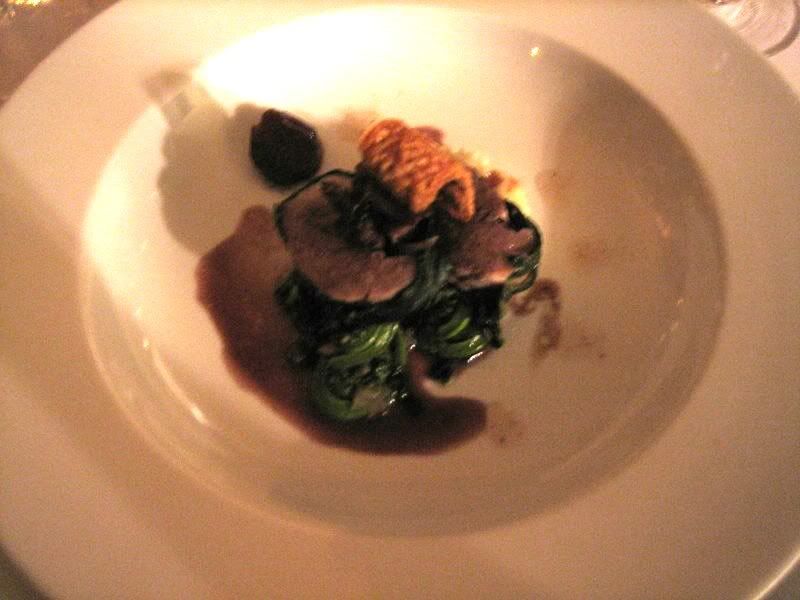
The skin and fat from the duck breast was salted and rendered to create a modified "crackling" which was served atop the meat, adding a delicious salty and texturally crisp antagonist to the smooth and tender meat and accompaniments.
Topping the duck was a pan reduction infused with roasted shallots, reduced from a red-wine infused duck stock. Both smooth and somewhat acidic, with the sweetness of caramelized shallots, the sauce provided a silky texture which tied the dish together. Further flavor was added with the presentation of cardamom oil to frame the plate.
This complicated presentation of duck-- robust in flavor-- was complemented by another Australian wine selection-- Jacob's Creek Vineyard, Reserve Shiraz, 2004. The first still red wine of the evening, it set the stage for future offerings, including Cabernet Sauvignon, Bordeaux, and of course, a tasting of Ports. But you'll have to keep checking back to hear about those (and the foods they were paired with!)
Monday, July 09, 2007
a birthday degustation: course five
 Our trip down culinary memory lane continues with a review of course 5 of our recently prepared 11 course chef's degustation menu. As we have mentioned in previous posts, our culinary aesthetic focuses on fresh ingredients, prepared simply to highlight their clean, unadulterated flavors through a variety of cooking techniques. We prefer locally grown organic produce, which this current course highlighted-- locally grown baby artichokes. To best showcase these tender and delicious morsels, we presented the artichokes with three different preparations... artichokes, three ways!
Our trip down culinary memory lane continues with a review of course 5 of our recently prepared 11 course chef's degustation menu. As we have mentioned in previous posts, our culinary aesthetic focuses on fresh ingredients, prepared simply to highlight their clean, unadulterated flavors through a variety of cooking techniques. We prefer locally grown organic produce, which this current course highlighted-- locally grown baby artichokes. To best showcase these tender and delicious morsels, we presented the artichokes with three different preparations... artichokes, three ways!Paired with our three artichokes was a delightfully crisp and refreshing sparkling red wine from Australia (Lengs & Cooter, Sparkling Red Wine, McLaren Vale). The earthy, yet crisp bubbly wine complimented the natural flavors of corn, artichokes, and chestnut beautifully, and was only enhanced by the acidity of the barigoule vinaigrette.
Thursday, July 05, 2007
a birthday degustation: course four
 After a slight delay (due to technical difficulties here at the orenji catering offices), we continue our culinary tour of the recent chef's degustation and wine tasting we prepared for a friend and client.
After a slight delay (due to technical difficulties here at the orenji catering offices), we continue our culinary tour of the recent chef's degustation and wine tasting we prepared for a friend and client.Tuesday, July 03, 2007
a birthday degustation: course three
 We continue our culinary journey, recapping our recent chef's degustation and wine taste prepared in honor of a friend and client's birthday. Course three, a "flight" of chilled soups, came next, highlighting the fresh spring flavors of local produce in easy to drink "shots" of soup.
We continue our culinary journey, recapping our recent chef's degustation and wine taste prepared in honor of a friend and client's birthday. Course three, a "flight" of chilled soups, came next, highlighting the fresh spring flavors of local produce in easy to drink "shots" of soup.The first of the flight of three soups was an English pea soup. Delicate English peas were shelled, blanched, and pureed with vegetable stock and seasonings. Following straining and chilling, the soup was topped with fresh oil infused with essence of white truffle, and served with an oven crisp of Parmigiano Reggiano cheese. The color of the soup was a vibrant bright green, with the taste sweet and smooth-- the concentrated essence of light and fresh peas accentuated by the deep flavor of white truffles.










